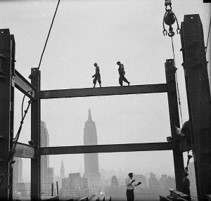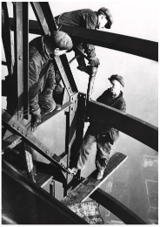There has recently been a determined effort on the part of various special interest groups to suggest that pervasive fraud is being successfully worked upon the courts and people of the State of New York. These agenda driven interest groups have been trying for decades to overturn the health and safety provisions of New York State’s Labor Law, and are now trying an approach driven by wildly exaggerated allegations of pervasive fraud.
Background:
For more than 100 years (since roughly 1885) New York, as the great center of commerce, and thereby of construction, has been a national leader in efforts to make the construction site a safer place for its workers. This is because construction work is, inherently, very dangerous, and the construction industry has one of the highest numbers of work-related fatalities suffered by the workers of any industry segment.

Among the New York laws that seek to accomplish this important construction site safety goal, are the Labor Law provisions that have been the target of these recent resurgent self-serving interest group attacks (NYS Labor Law §§ 200, 240(1), and 241(6), among others). These laws make sure that the ultimate responsibility for construction site safety falls to the businesses that are profiting from the work, rather than to the workers who are, at great personal risk, actually performing the work to support their families. The workers who “…are scarcely in a position to protect themselves… 1 ;” given the hierarchy structuring construction site relationships from Owner to General Contractor, to Subcontractor, to Foreman, to laboring Workers, need protection imposed by regulation. So the owners of construction projects, and the construction firms that are operating those sites, are held non-delegably responsible for safety on the construction sites that they own, operate, and from which they profit.
This long-standing public policy risk allocation makes perfect sense. A safety driven culture definitely flows from the boss downward. Expressions like “Just get it done” or “I want that finished yesterday” are not uncommon in any workplace, but on a construction site, prioritizing fast over safe can have devastating consequences. Using the safest method for doing the work is usually not the fastest way, nor is it, in the short term, the cheapest way, and for the project owners, quite naturally, time is money.

So the New York State Legislature had to decide whether a laissez-faire approach to balancing worker safety and owner profit was the best course, or whether, as a matter of beneficent public policy, the scales should be tipped in favor of safety, especially in some of the most dangerous aspects of construction work, dangers driven by gravity. Safety was determined to be more in need of protection than profit. Again, this outcome is a commonly sensible one. Entities that own construction projects have a very natural impetus to find efficiencies leading to better profit margins. No legislative enactment is needed to remind a businessman that he should try to make as much money as possible with the least possible outlay of expense; whereas, in the contest between safety and expedience, because as a society we want safety to win, our legislature has for much more than just 4 score and 7 years, been trying to give safety a little boost on its uphill course. There can be no thoughtful honest argument to the contrary, this approach is the right one. Safety for the vulnerable many, is more of a public concern than profit for the powerfully entrenched few, and it should be the subject of strong regulatory protections. Our State has always been a leader when it comes to the codification of lexical priority in favor of protecting the public over the competing special interests of some or another group in opposition to that public good.
Fraud is a thing:
Just as the truth that safety should be prioritized over profit cannot be contested, it is also incontestably true that in nearly every place where unethical people can find a profitable fraud to perpetrate, a fraud will sometimes occur.
The legal system is not immune from this fact of life. False claims advanced in an effort to secure some benefit for their claimant, have been brought before judicial tribunals since long before the first English common law jury was empaneled to seek truth. There have, no doubt, been some recent well documented (and videotaped) false claims arising from construction sites, but there have also been false claims advanced in criminal cases, from the ubiquitous formal plea of “not guilty” to the more deceitful claim that “I did not pay that actress for her silence.” The point of the judicial system is to find truth and to weigh evidence with an ethical unbiased arbiter. Where a false claim or contention is advanced our system is designed to ferret it out and prevent injustice. It is very well known that people do not all have that George Washington “I cannot tell a lie” mentality. Finding a falsehood, even a flagrant one, is not a justifiable reason to undo a century of developing safety focus, exposing the most vulnerable link in the construction chain to very real and significant danger.
According to the U.S. Bureau of Labor Statistics, the construction industry consistently has one of the highest rates of fatal work injuries in the U.S., and falls from heights are a leading cause of those construction site fatalities.2 Moreover, not only are construction sites among the most dangerous places to work, but the most vulnerable people working on them are by far the most likely to be injured or killed. Immigrants,3 non-union workers,4 and other economically disadvantaged groups make up a disproportionate number of the total incidents of morbidity and mortality in this setting.
The less regulation, the less organization, and the least ability to fight the powers that be in construction yield an immediately recognizable increase in injury and death. Shockingly, these special interest groups in advancing their own Jonathan Swift style Modest Proposal,5 are actually in earnest suggesting this nefarious course of action. Taking away construction site safety measures should never be even contemplated as a path toward more profitability in the construction industry.
Common sense, the statistics of the U.S. BLS, OSHA, and NYCOSH, and more than a century of New York construction safety experience make this perfectly clear, and no occasionally occurring fraud, even if caught on camera, can outweigh the overwhelming conclusive evidence of construction site dangers hurting and killing the workers who ply their trades exposed to these risks.
Fighting Construction Cost Inflation:
Happily, the same special interest groups that are advocating for an elimination of construction site safety regulation, have another practice already in place that might well lead us in a better direction toward holding these costs down. When an accident does occur on a construction site, and it is witnessed by thousands of New Yorkers, and caught on multiple cameras, does the construction industry, or its insurance industry partners, immediately step forward and compensate the injured workers? Certainly not. Instead, these cases, even the obviously incontrovertible ones, are litigated for years. Dozens of law firms fought in courts for thousands of hours about the recent crane collapses in New York City where shoddy equipment and totally deficient inspection and monitoring injured and killed many workers. It is not just the giant news stories where these injured workers are dragged through the courts for years, it is in almost every single case.
Knowing this, the insurance industry has literally invented a whole new profession, and it is a booming one. There are now literally dozens of multi-million-dollar companies whose sole function is to review every bill that any insurance or construction defense lawyer submits to the insurer for payment.6 So every time that a construction defense lawyer submits a bill, the insurer has an outside company who reviews it and eliminates any excesses to hold down costs.
So if the cost of a few frauds make so big a difference to insurance companies that the overwhelming majority of legitimately injured workers, in one of the most dangerous industries, should be stripped of their benignant regulatory protections, imagine how much litigation expense could be saved by fairly compensating injured workers right away, once the unlikely prospect of a potential fraud has been eliminated. Years of litigation expense, years of accruing interest, years of the expense of having a company review your defense legal bills, all could be eliminated by fairly compensating injured workers so that they can maximize their medical recovery, care for their families whom they were working to support in the first place and get on with the business of their lives.
Authored by
Jason Richman, Esq | New York Civil Trial and Appellate Attorney
Footnotes:
- “…And what the statute declares, its reason confirms. Workmen such as the present plaintiff, who ply their livelihoods on ladders and scaffolds, are scarcely in a position to protect themselves from accident. They usually have no choice but to work with the equipment at hand, though danger looms large…” Koenig v. Patrick Const. Corp., 298 N.Y. 313, 318-319 (1948)
- U.S. Bureau of Labor Statistics. “A look at falls, slips, and trips in the construction industry” May 06, 2024. [“In 2022, nearly 1 in 5 workplace deaths occurred in the construction industry and 38.4 percent of these deaths were due to falls, slips, and trips. The construction industry accounted for close to half, 47.4 percent, of all fatal falls, slips, and trips in 2022.”] From: https://www.bls.gov/opub/ted/2024/a-look-at-falls-slips-and-trips-in-the-construction-industry.htm#:~:text=In%202022%2C%20nearly%201%20in%205%20workplace,fatal%20falls%2C%20slips%2C%20and%20trips%20in%202022.
- Data from the U.S. Bureau of Labor Statistics and OSHA show that immigrant workers, particularly Latino workers, are disproportionately represented in fatal construction accidents. Nationally, Latino workers are more likely to suffer serious or fatal injuries compared to their non-immigrant counterparts. In 2020, Latino workers accounted for 22.5% of all construction fatalities, despite representing a smaller percentage of the overall workforce. Accessed from: https://www.bls.gov/opub/ted/2022/share-of-workplace-deaths-among-hispanic-and-latino-workers-continued-to-rise-in-2020.htm
- New York Committee for Occupational Safety and Health (NYCOSH). 2022 Annual Report. Deadly Skylines. [“NYCOSH analyzed OSHA’s 29 construction fatality investigations in 2020 and found that in New York State, 79% of workers who died on private worksites were non-union. In the 7 OSHA investigated sites in New York City, 100% of the construction workers who died were non-union. Non-union contractors have little oversight outside of government regulatory agencies, and with OSHA’s underfunding, worksites are not receiving the number of inspections necessary to ensure safety standards are being followed. Union job sites have shop stewards and a trained workforce that are more likely to recognize and report safety violations and have protection from their union against retaliation from their employer.”]
- Jonathan Swift, 1729. A Modest Proposal For Preventing the Children of Poor People From Being a Burthen to their Parents, Or the Country, and For Making Them Beneficial to the Publick. A satirical essay suggesting that the babies of the poor should be eaten in order to control the growing population, reduce poverty, and to provide a new natural resource for industry.
- Legal Bill Revew.com listing of just the top seven such companies. From: https://blog.legalbillreview.com/top-legal-bill-review-companies/
